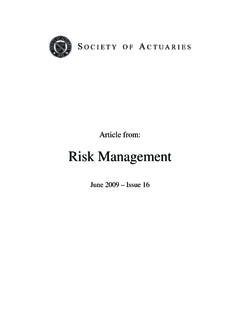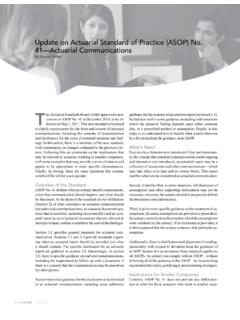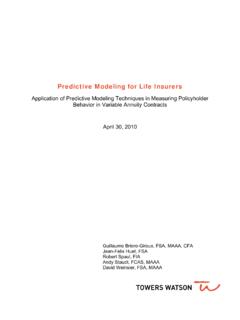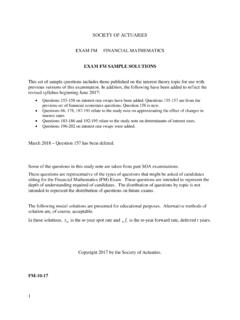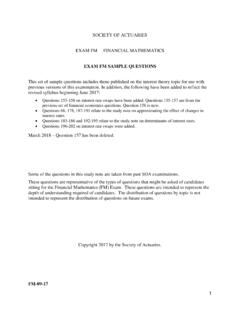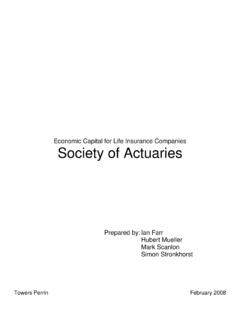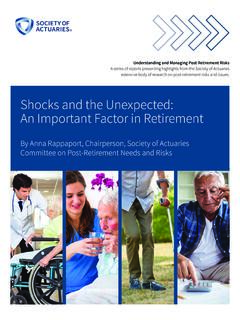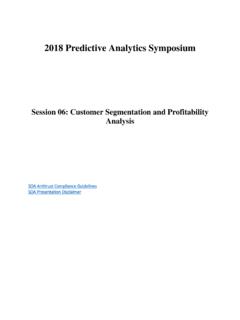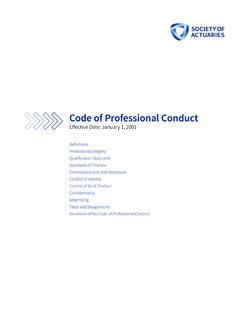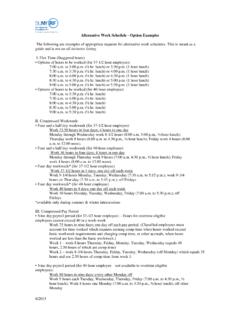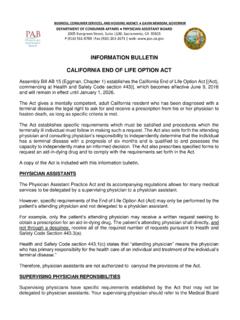Transcription of (1) Consider a European call option and a European put ...
1 1 5/20/2008 (1) Consider a European call option and a European put option on a nondividend-paying stock. You are given: (i) The current price of the stock is $60. (ii) The call option currently sells for $ more than the put option . (iii) Both the call option and put option will expire in 4 years. (iv) Both the call option and put option have a strike price of $70. Calculate the continuously compounded risk-free interest rate. (A) (B) (C) (D) (E) 2 5/20/2008 Solution to (1) Answer: (A) The put-call parity formula for a European call and a European put on a nondividend-paying stock with the same strike price and maturity date is C P = S0 Ke rT.
2 We are given that C P = , S0 = 60, K = 70 and T = 4. Then, r = Remark 1: If the stock pays n dividends of fixed amounts D1, D2,.., Dn at fixed times t1, t2,.., tn prior to the option maturity date, T, then the put-call parity formula for European put and call options is C P = S0 PV0,T(Div) Ke rT, where PV0,T(Div) = =niirtieD1is the present value of all dividends up to time T. The difference, S0 PV0,T(Div), is the prepaid forward price )(,0 SFPT. Remark 2: The put-call parity formula above does not hold for American put and call options . For the American case, the parity relationship becomes S0 PV0,T(Div) K C P S0 Ke rT.
3 This result is given in Appendix 9A of McDonald (2006) but is not required for Exam MFE/3F. Nevertheless, you may want to try proving the inequalities as follows: For the first inequality, Consider a portfolio consisting of a European call plus an amount of cash equal to PV0,T(Div) + K. For the second inequality, Consider a portfolio of an American put option plus one share of the stock. 3 5/20/2008 (2) Near market closing time on a given day, you lose access to stock prices, but some European call and put prices for a stock are available as follows: Strike Price Call Price Put Price $40 $11 $3 $50 $6 $8 $55 $3 $11 All six options have the same expiration date.
4 After reviewing the information above, John tells Mary and Peter that no arbitrage opportunities can arise from these prices. Mary disagrees with John. She argues that one could use the following portfolio to obtain arbitrage profit: Long one call option with strike price 40; short three call options with strike price 50; lend $1; and long some calls with strike price 55. Peter also disagrees with John. He claims that the following portfolio, which is different from Mary s, can produce arbitrage profit: Long 2 calls and short 2 puts with strike price 55; long 1 call and short 1 put with strike price 40; lend $2; and short some calls and long the same number of puts with strike price 50.
5 Which of the following statements is true? (A) Only John is correct. (B) Only Mary is correct. (C) Only Peter is correct. (D) Both Mary and Peter are correct. (E) None of them is correct. 4 5/20/2008 Solution to (2) Answer: (D) The prices are not arbitrage-free. To show that Mary s portfolio yields arbitrage profit, we follow the analysis in Table on page 302 of McDonald (2006). Time 0 Time T Time T Time T Time T ST < 40 40 ST < 50 50 ST < 55 ST 55 Buy 1 call Strike 40 11 0 ST 40 ST 40 ST 40 Sell 3 calls Strike 50 + 18 0 0 3(ST 50) 3(ST 50) Lend $1 1 erT erT erT erT Buy 2 calls strike 55 6 0 0 0 2(ST 55) Total 0 erT > 0 erT + ST 40 > 0 erT + 2(55 ST) > 0 erT > 0 Peter s portfolio makes arbitrage profit, because.
6 Time-0 cash flow Time-T cash flow Buy 2 calls & sells 2 puts Strike 55 2( 3 + 11) = 16 2(ST 55) Buy 1 call & sell 1 put Strike 40 11 + 3 = 8 ST 40 Lend $2 2 2erT Sell 3 calls & buy 3 puts Strike 50 3(6 8) = 6 3(50 ST) Total 0 2erT Remarks: Note that Mary s portfolio has no put options . The call option prices are not arbitrage-free; they do not satisfy the convexity condition ( ) on page 300 of McDonald (2006). The time-T cash flow column in Peter s portfolio is due to the identity max[0, S K] max[0, K S] = S K (see also page 44).
7 In Loss Models, the textbook for Exam C/4, max[0, ] is denoted as +. It appears in the context of stop-loss insurance, (S d)+, with S being the claim random variable and d the deductible. The identity above is a particular case of x = x+ ( x)+, which says that every number is the difference between its positive part and negative part. 5 5/20/2008 (3) An insurance company sells single premium deferred annuity contracts with return linked to a stock index, the time-t value of one unit of which is denoted by S(t).
8 The contracts offer a minimum guarantee return rate of g%. At time 0, a single premium of amount is paid by the policyholder, and y% is deducted by the insurance company. Thus, at the contract maturity date, T, the insurance company will pay the policyholder (1 y%) Max[S(T)/S(0), (1 + g%)T]. You are given the following information: (i) The contract will mature in one year. (ii) The minimum guarantee rate of return, g%, is 3%. (iii) Dividends are incorporated in the stock index. That is, the stock index is constructed with all stock dividends reinvested. (iv) S(0) =100. (v) The price of a one-year European put option , with strike price of $103, on the stock index is $ Determine y%, so that the insurance company does not make or lose money on this 5/20/2008 Solution to (3) The payoff at the contract maturity date is (1 y%) Max[S(T)/S(0), (1 + g%)T] = (1 y%) Max[S(1)/S(0), (1 + g%)1] because T = 1 = [ /S(0)](1 y%)Max[S(1), S(0)(1 + g%)] = ( /100)(1 y%)Max[S(1), 103] because g=3 & S(0)
9 =100 = ( /100)(1 y%){S(1) + Max[0, 103 S(1)]}. Now, Max[0, 103 S(1)] is the payoff of a one-year European put option , with strike price $103, on the stock index; the time-0 price of this option is given to be is $ Dividends are incorporated in the stock index ( , = 0); therefore, S(0) is the time-0 price for a time-1 payoff of amount S(1). Because of the no-arbitrage principle, the time-0 price of the contract must be ( /100)(1 y%){S(0) + } = ( /100)(1 y%) Therefore, the break-even equation is = ( /100)(1 y%) , or y% = 100 (1 1 )% = Remark 1 Many stock indexes, such as S&P500, do not incorporate dividend reinvestments.
10 In such cases, the time-0 cost for receiving S(1) at time 1 is the prepaid forward price 0,1()PFS, which is less than S(0). Remark 2 The identities Max[S(T), K] = K + Max[S(T) K, 0] = K + (S(T) K)+ and Max[S(T), K] = S(T) + Max[0, K S(T)] = S(T) + (K S(T))+ can lead to a derivation of the put-call parity formula. Such identities are useful for understanding Section Exchange options in McDonald (2006). 7 5/20/2008 (4) For a two-period binomial model, you are given: (i) Each period is one year.
